|
To help the novice on riding an old 16H or Big4 motorcycle.
I give my personal way of doing it with some additions by others.
Its not giving the
ultimate procedures, just the way I do it, and its up to anybody to see what
he does with it.
USE OF PETROL:
For petrol, I use unleaded 95 Octane (RON) fuel ("Euro 95", but may be
named differently depending on the country you live in) since introduced in Holland
several years ago. I have never added any lead supplement or other additions
to the fuel.
These bikes were designed in the mid 1930 ties, in a time when leaded high
octane fuel was only used for high performance aeroplane engines, and
definitly not for down to earth sidevalve motorcycles.
Between 1939 and 1949 the only available petrol was "Pool Petrol".
"Pool Petrol meant that the
physical assets, working capital and manpower of all petrol companies in the
United Kingdom were pooled, each company receiving remuneration and
depreciation on the assets contributed at agreed rates; prices, quantities and
qualities of petroleum products came under Government control and competitive
marketing between suppliers ceased; products were supplied by the members of
the Board as far as possible in proportion to their pre-war deliveries, all
(except lubricants) were sold under a Pool description, the selling price of
each Pool product being subject to Government control.
The controlled prices were as far as possible fixed with a view to covering
the costs of the Board without providing any profit.
Lubricating oil was the subject of separate pooling
arrangements. The Lubricating Oils Pool was formed of 21 importers of base
oils (including petrol companies), from whom it took over stocks, vehicles and
storage facilities. Lubricants continued to be sold under brand names
throughout the war. The Pool acted as sole wholesale seller of lubricants,
supplying over 500 distributors and providing base oils of 30 different
qualities."
(Info from CHAPTER 2. HISTORICAL
DEVELOPMENT OF THE RETAIL MARKET FOR PETROL IN THE UNITED KINGDOM,
report ?? from the British "Competition Commision" website).
Octane ratings for
pool petrol ranged between 67 and 80 percent, indicating that the present day
petrol is far more explosion resistant than in those years. I am rather
convinced you can have the bikes running on petroleum or white spirit.
The additon of
lead was introduced to increase the "explosion resistance" and prevent "early
combustion" of petrol, required for high compression engines. Increasing
pressure leads to a higher tendency of the mixture to explode instead of burn
or combust before top dead centre of the engine is reached. Neither of these
tendencies is good for any engine.
It leads to overheating and loss of power.
Added advantage is that lead will work as a lubricant on e.g. valve seats.
With the relative low milage made with these machines nowadays (I do about
1000 km per year) I feel the additional wear on the valve (if so) to be
acceptable.
USE OF OIL:
For engine oil, the original publications give straight SAE50 monograde oil.
Its harder to get nowadays, but local oil suppliers still have it, and at a
reasonable price. Don't go to the specialised motorcycle shop. They make
millions on it. Companies delivering oil to for instance the inland shipping
companies usually have it at a much better price. (e.g. Metropa Rotterdam, see
links page).
If you cannot find Straight SAE50 oils, you can use 20W/50 multigrade oil, but
if you have run on monograde before then you will first have to clean out the
engine and oil system properly. Single grade oils are not so good in
"catching" polutions in the oil. Using a multigrade oil after monograde oil
may lead to the loosening of old sludge/dirt from the system. It might then
block oilways.
I have used multigrade for about 10 years before I found a new monograde
supplier. Because of it general lower viscosity, 20W/50 seems to leak a bit
more!
For the gearbox,
the documentation also gives the straight SAE 50 type oil. Here I have made an
exception. I use SAE 80 hypoid oil in my gearbox. Not really thicker, but much
better lubrication quality and especially developed for gearboxes. I just
think it is better. I have spoken to other old bike riders and sometimes they
actually add grease to the oil as well. If you have a leaky gearbox, that
might help to reduce the bikes tendency "to mark its spot".
In General, my
motto is,
"if it does not leak, thán you have to worry"!! (Not for my BMW though!)
STARTING
Starting the beast can be gruelsome, or a piece of cake. Below two
procedures found in Norton riders handbooks.
The official way described in the riders manual of 1940 is as
follows:
"With the petrol turned on and the carburetter slightly flooded, depress the
kick-starter until the engine is on the compression stroke, that is, until it
is impossible readily to depress the starter any further. Now raise the
exhaust valve lifter and depress the kick-statrter a further two or three
inches. Release the exhaust valve lifter and allow the kick-starter to return
to its normal position. A long swinging kick on the starter should now start
the engine, provided that the throttle is correctly set."
Missing in the description is the setting of air valve, ignition
and throttle.
A later description found in a post 1942 riders handbook
states the following procedure:
"Close air lever, set ignition two-thirds advanced
position.
Note: - with cold engine only, depress the plunger on
top of the carburetter float chamber until it is apparent (by feel) that the
chamber is full
of petrol. Do not allow the petrol to flood until it is oozes out of the
carburetter. Free engine by depressing the kick-starter several
times with the exhaust lifter control raised.
Set throttle slightly open.
Depress the kick-starter as far as possible WITHOUT using the exhaust lifter
control.
Raise the exhaust lifter control.
Depress the kick-starter a further inch.
Release the exhaust lifter control and allow the kick-starter to return to its
normal position.
Give the kick-starter a long swinging kick, WITHOUT using the exhaust lifter
control.
The engine should then fire.
If the engine back-fires, further retard the iginition, close the throttle a
little, ands try again.
Do not rest the foot on the kick-starter cranck while the engine is running."
The slightly alternative way I use is that I doo lift the exhaust valve at the
beginning of the long swinging kick in the assumption that it will result in a
slightly faster rotation of the flywheel and thus aids the starting process.
Be sure not to keep air valve open too long of course. Then you won't have
sufficient fuel inhaled or have enough compression!
A trick aired on the BSA M20 Forum goes as follows:
"When cold, tickle the carb, open the throttle fully for a couple of seconds
for the petrol fumes to enter the inlet, close the throttle and proceed as
usual".
In the end I have found every bike to be different, and
you will have to fiddle around a bit to find the best way for your bike.
IGNITION TROUBLES
The above given procedures assume that your ingition
coil in the Magneto is working properly and that there is no "leak"anywhere in
your electrical system diverging the sparks to the wrong place.
These magneto's were never made to last 60 + years, and the materials used
then do have their limits with respect to life.
Especially the Shellack, the dark orange/brown lacquer visible on the outside
of the original coils, and used on the copper wire itself as well, has a
restricted life. Its a natural product which has been around for over 3000
years! basically as varnish to coat all kinds of materials.
It will be reasonable when kept in the cold all the time, but that is not a
realistic condition. Most coils will have become warm in their life and with
that the Shellack degrades. A tell tale for a coil gone "to meet its makers"
is that it feels a bit "soggy"when you pinch in it.
A good coil with a chance for being still working,
should feel rock hard. Most coils however feel soft, indicating that the
Shellack has deteriorated and partly migrated from the place it should be. In
some magneto's you can even find blots of shellack sticking to various parts
of the static internals of the magneto, where it has become so soft it was
thrown from the rotor.
Another tell tale of a bad coil is that a motorcycle
starts OK when cold, but becomes very hard to start when hot. Due to the
softening of the Shellack, windings short circuit and thus reduce the "power"
being generated in the coil leaving a weak spark to do the job.
There is only one cure for this and that is to have the
coil rewound. Nowadays that is done using very good temperature resistant
epoxy resins virtually making them indestructible for the rest of your life.
During the rewinding, its alo best to replace the Condenser/Capacitor in the
rotor as well.
These were also never designed for an eternal life and although they might
still work, you have more certainty by replacing them with more modern
equivalents.
A faulty Condensor/Capacitor is indicated when there is a large spark coming
from the contact points, and this mostly accompanies a rather large
damaged/eroded spot on you contact points. The spark between the contact
points should just be a tiny and hardly visible in daylight.
IGNITION
TIMING SPECIFICATIONS
The ignition timing settings are a bit confusing.
Depending on the source there are rather different specifications.
E.M. Franks book "Norton" first published in 1948 gives a timing of 3/8
inch (9,53 mm) before TDC. Motorcycling Maintenance series Norton Motor
cycles 1928 - 1955 gives a timing of 7/32 inch (5,6 mm) for period of 1928 to
1937 and of 7/16 inch (11,11 mm) from 1938 upto 1954. The military M&I manual
gives a timing of 7/16 inch as well.
Having had the M&I manual almost from the beginning, I have always used 7/16
inch value, and it seems OK for me.
This all shows that the actual timing is less precise then some people think
it to be. Its my guess that this is basically because it is a mnaully
controlled operation. A precise setting can be totally ruined if the handlebar
control is abused!
Setting of
ignition timing:
Here you can find two ways of ignition timing. One as
given by Lex Schmidt and based on years of experience, the other the original
factory proposed way. Its up to the reader what to follow.
Lex states: This is what I always do and it can hardly go wrong. It works
because of the higher octane fuels as presently available and you don't need
to measure anything. Especially handy when timing overhead valve bikes
without a hole to measure the piston position.
1 loosen the nut/chainwheel at the magdyno drive side.
2 set the ingintion lever to fully retard position (on factory
standard Nortons, the position with least tension on the cable)
3 place piston in Top Dead Centre of the compression stroke
4 position the contact points such that they are barely start to open
(use cigarette paper between the points, it should just start to slide)
5 fasten the nut on the magdyno chian wheel without changeing the
settings.That should do the trick. At the fully advanced position,
this setting will be slightly early compared to the original manufacturers
setting. The higher octane number of the petrol does make this possible. You
can change the lever setting such that the engine runs properly.
Factory instruction:
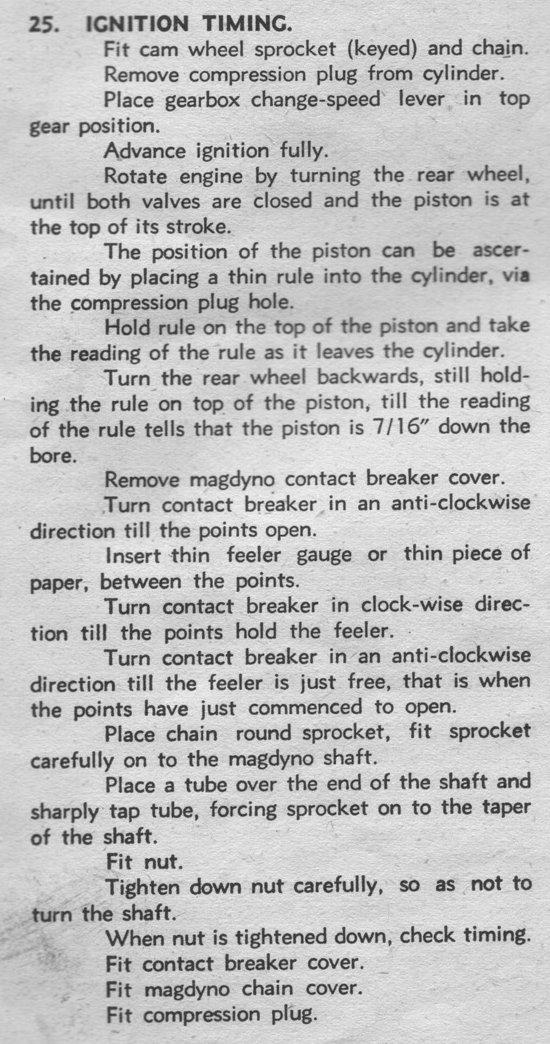
CarbuRation
For people not having acces to all information I hereby show the
pages from the pre-war maintenance manual showing the settings of the
carburetter.
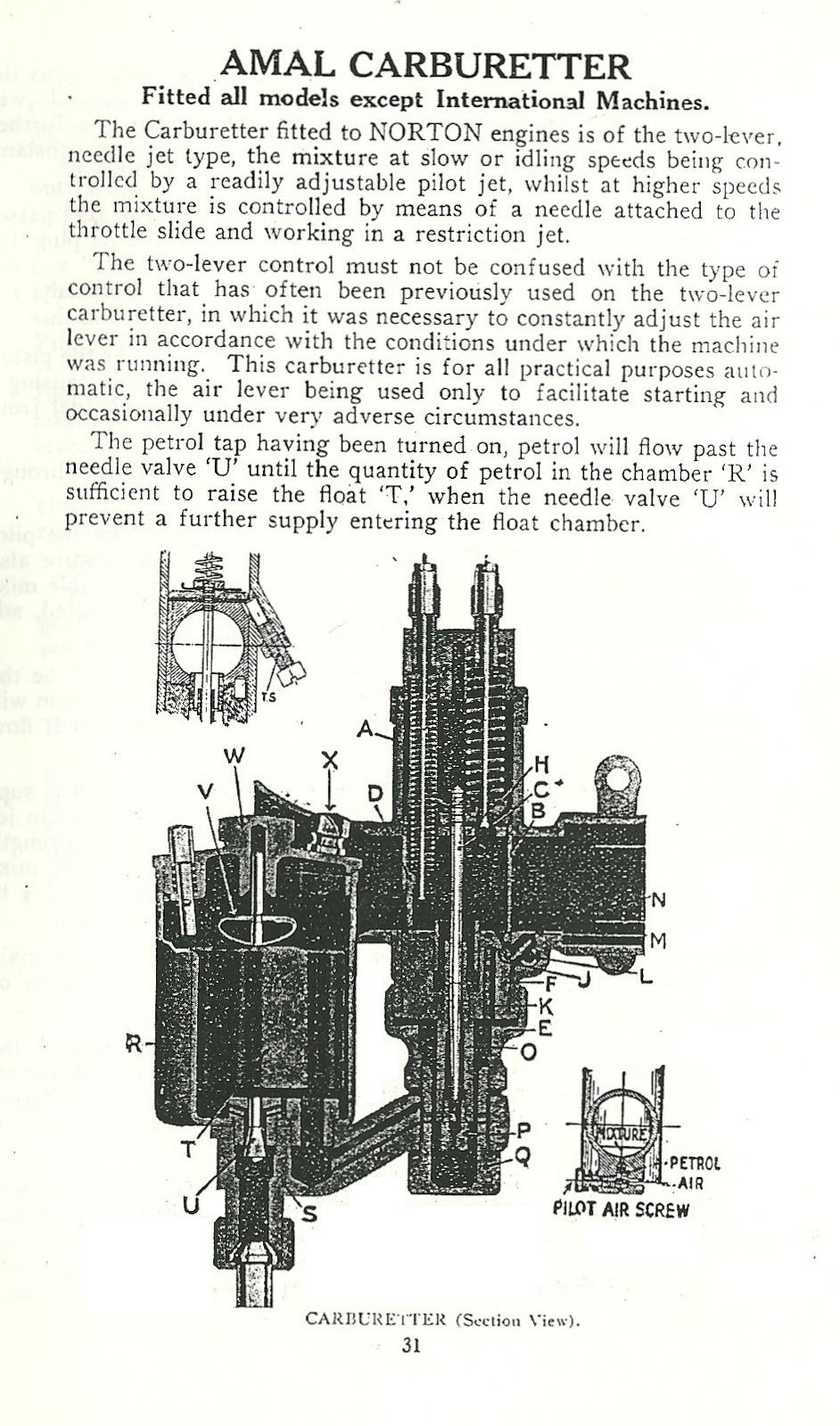
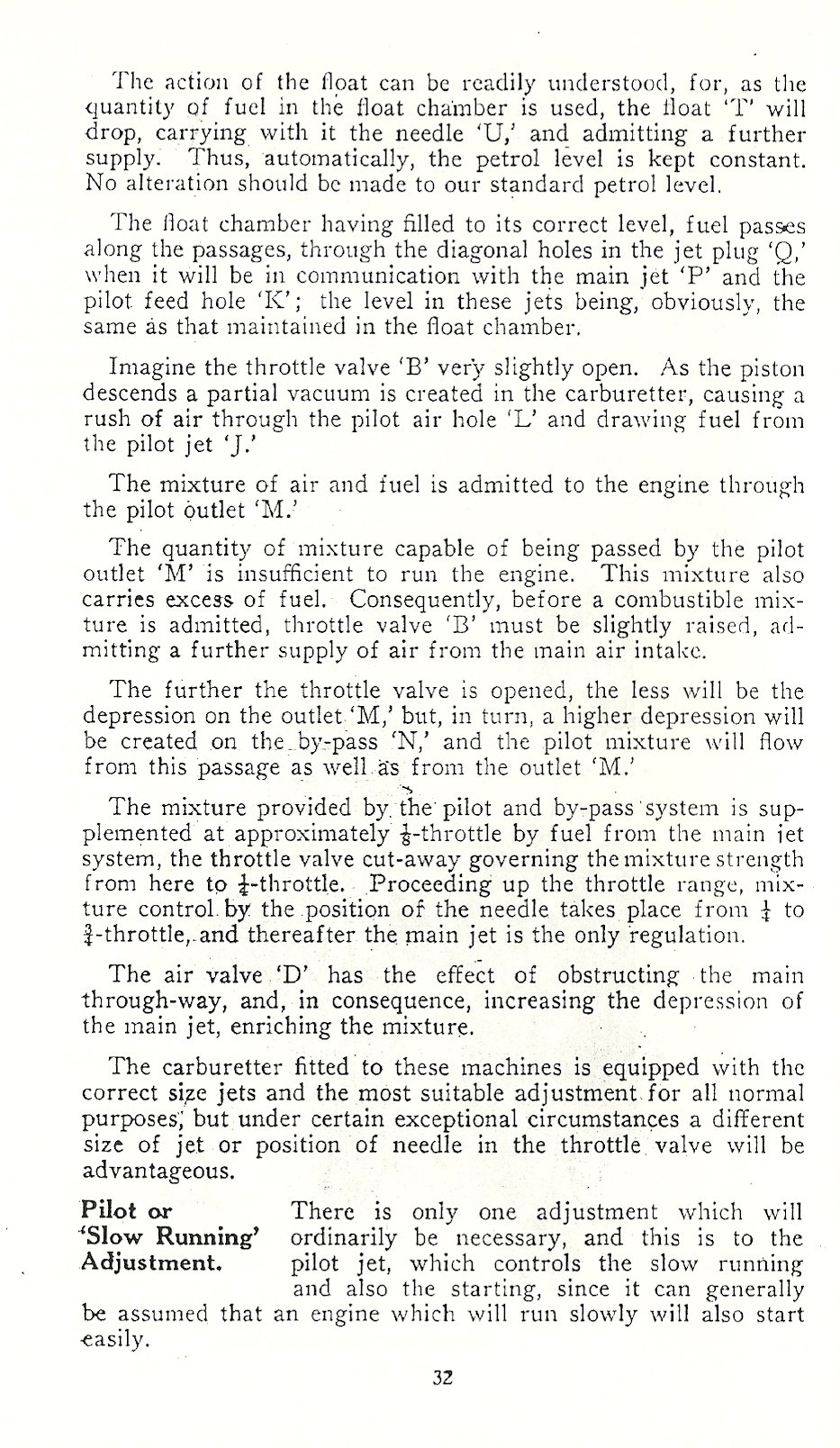
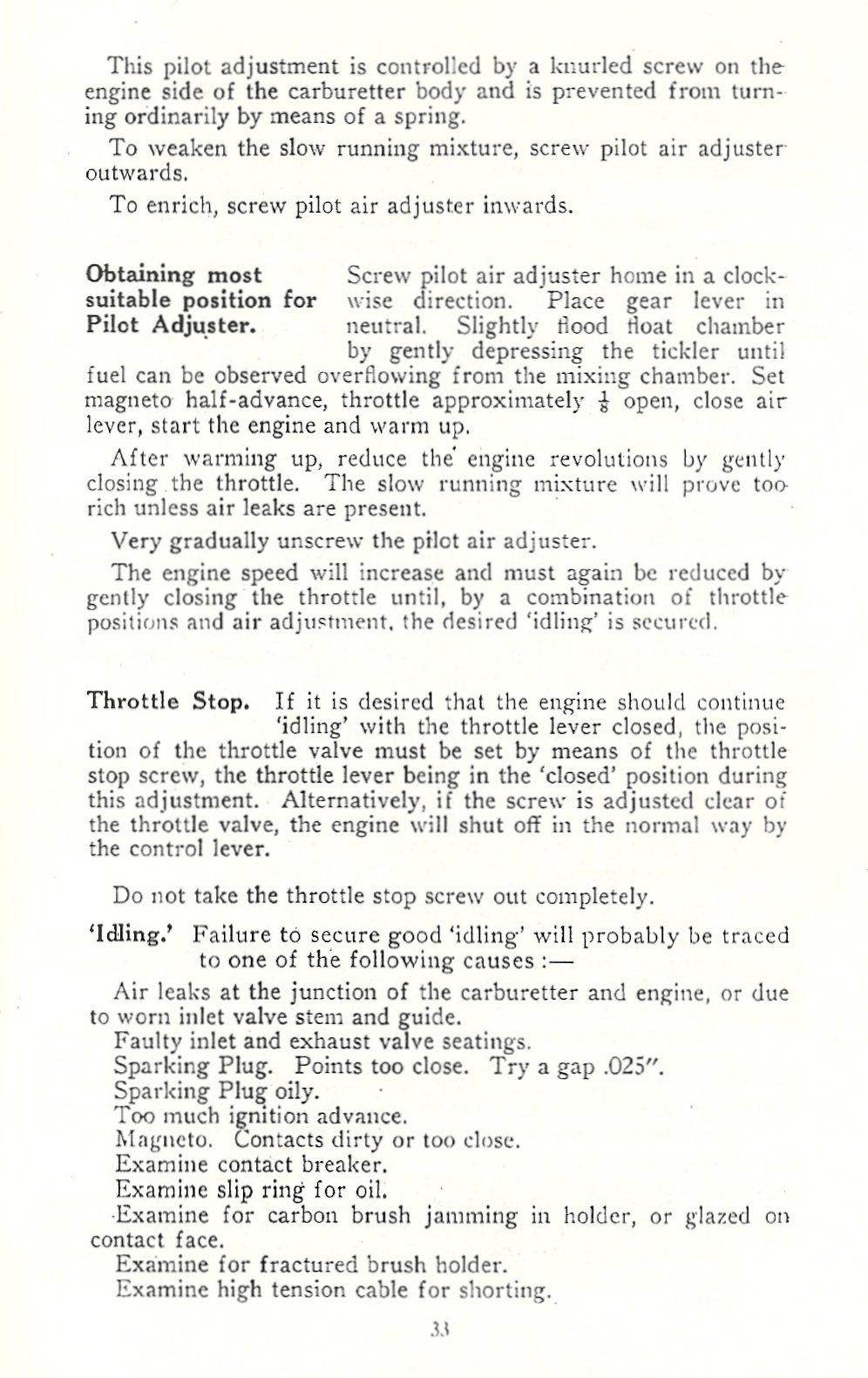

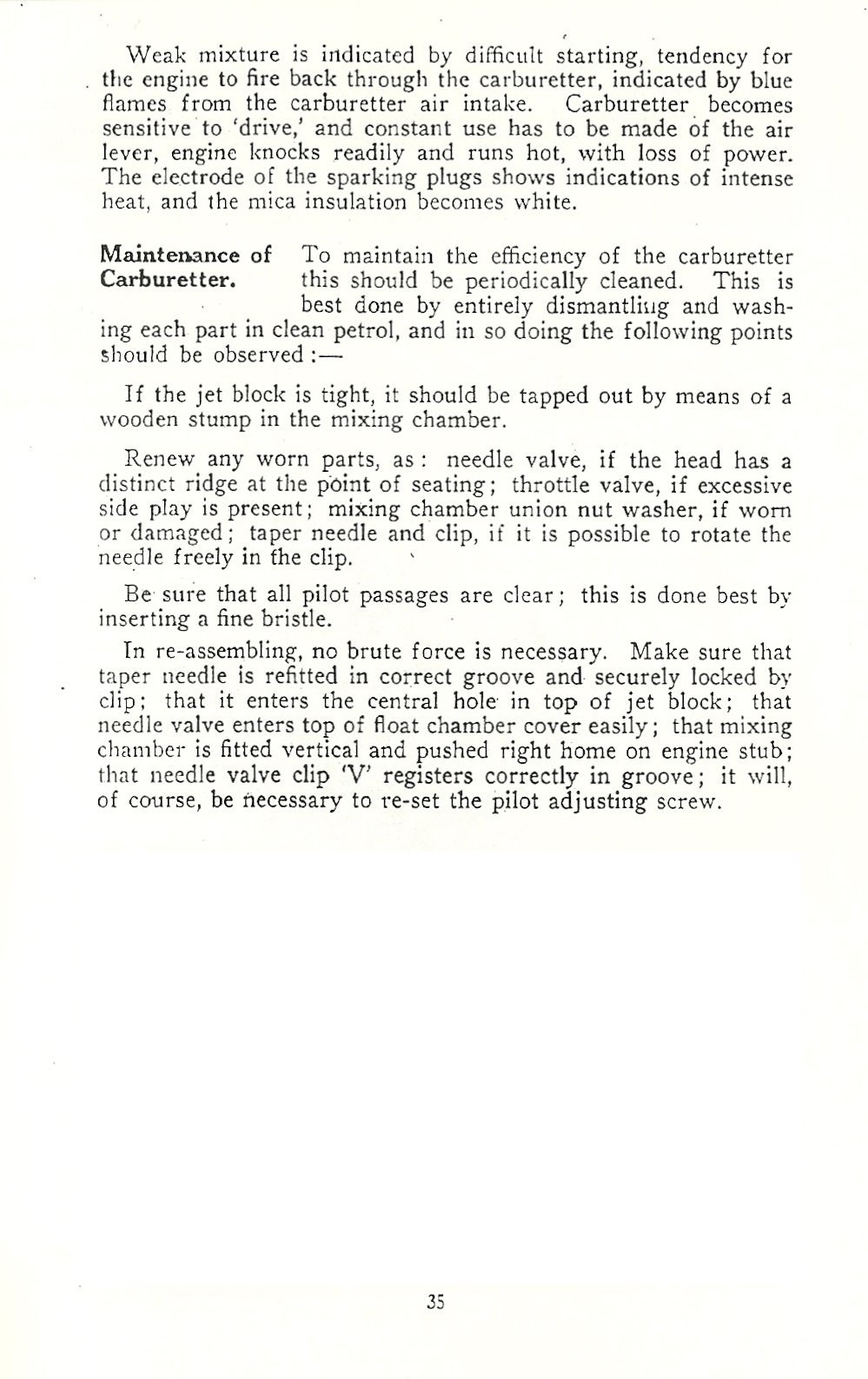
|

